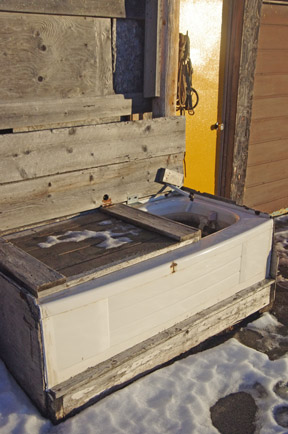
Another adaptation, of ‘using’ that great mop of a forelock to hide what his eyes are displaying; in the wild, as a stallion, this, I am guessing, keeps an opponent guessing where the vision’s locked onto. With human interaction, I am guessing he doesn’t mind hiding under cover (and keeping his thoughts that way) too.
Winter, say First Nation native people, is when nature slows down, sleeps, hibernates, re-charges itself, a time for reflections. Feeding this morning, just before the seasons turn into longer days again (oh yes please!), the hoar frost is spikily luxuriant along the fence-line, and a thick furline sits atop the round bale where yesterday the fork handle broke and I had to paw its layers to turf over the fence line – my, what a procedure! I put out a hand, a silent ‘thank you’ to whoever invented iron in the first place, thought of even the idea of a fork and four tines – I mean, how useful an item to have invented for humanity!
Thanks, too, to my horse-language sympathetic farrier Bryan, who trimmed Mops on a windy day last week, both of them eyeing each other very carefully, but mutually respectful. It was another small, special significant moment of low stress, and where I thanked that article of Temple Grandin’s about learning with no fear all over again.

1. You think this is an old ordinary water trough?! Here’s another ‘gift’ I offer thanks daily on. Yes, it’s an old converted bath tub, probably dating back to 18-20 years. It’s insulated on top in winter months to shorten the air exposure of the water area with a fitted wooden rectangle glued onto polysterene blocks hidden beneath. The big deal on this trough is the absolutely constant water temperature (even in -40 degrees, seriously!), because the inner lining of the trough is wrapped around with a specialized electric ‘tape’ with a preset temperature capacity – this one runs at a constant 40 degrees F. (or 4 C.) At one end of the ‘trough’ is the electric switch mechanism to click on when temperatures zero downwards. In the summer, clip on a gravity feed on the water outlet, take off the top insulator and poof, all seasons change mode!
Then, yesterday afternoon where calling the Mops-horse and his pinto companion the Apache back into the overnighting corrals, it was the wildie colt – who’s going through small careful steps to make sure he’s respectful of neighbours’ fences with a very down-to-earth companion – who trotted right up to stand a mindful foot away, ears forward, from half a field away. Now, there’s trust and yes, I put my hand out again, palm up, thanking the horse ancestors and whoever else is around in that department for so many insights these last six months. That, before going alongside on that previously bent-away left-hand side that’s forgotten about that, to slide on a halter – in the middle of the field, in open spaces, a deal hard worked at but very much appreciated for the way it was earned by sheer hard work and awareness, always.
I noticed, too, the ‘groove’ line moving downward now on all four feet, that dates back pretty much to his arrival time when starvation wasn’t far away for the wildies after a brutally hard winter and stress factors, and when his diet changed to unlimited hay, mineral licks and, eventually, oats and hard feed to balance up feed deficiencies.
Another blessing trotted in with Equine Canada driving coach Kathleen Winfield emailing another ‘must-have’ book from her Millarville operations (for those beginning with teaching oneself as well as the horse – a beginner teaching a beginner, eek!). Heike Beane’s book “Carriage Driving – A Logical Approach through Dressage Training,” she writes, is “an excellent primer on starting your horse correctly! Between that and the Doris Ganton book, you have two of the best references available.”

The Bellcrown Badger comes recommended by a local experienced driving enthusiast
And, handily, just up the road although my bank manager would heartily disagree (sponsors anywhere, who want to come along on the ride to competing?!), is an absolute gem of a two-wheeled ‘cart’ (which, to the beginner here, sounds a heavy name for a beautifully crafted light piece of equipment) for sale, a Bellcrown Badger (see ad here). Why, I ask, is the two-wheel your ‘starter’ vehicle and hear that it’s a safety issue, a four-wheel can jackknife. This one, explains the well-seasoned owner, is easy to get in and out of too, with very decent suspension (driving, I am learning, is not for the faint-hearted or the faint-jointed) and a good ‘ride.’ This one’s a lightweight (I went to see one the other day that would have needed a team of Percherons to move out of stationary) which, I also learn, means the ‘drift’ around corners will be more noticeable. But if you’re female and not working out at the gym five days a week, is also way easier to move and heave about, and harness up to. And, I learned too, this particular model has shafts that are adjustable, in and out, so it’s not just a one-horse or one-pony size only deal.
We’re on our way.
